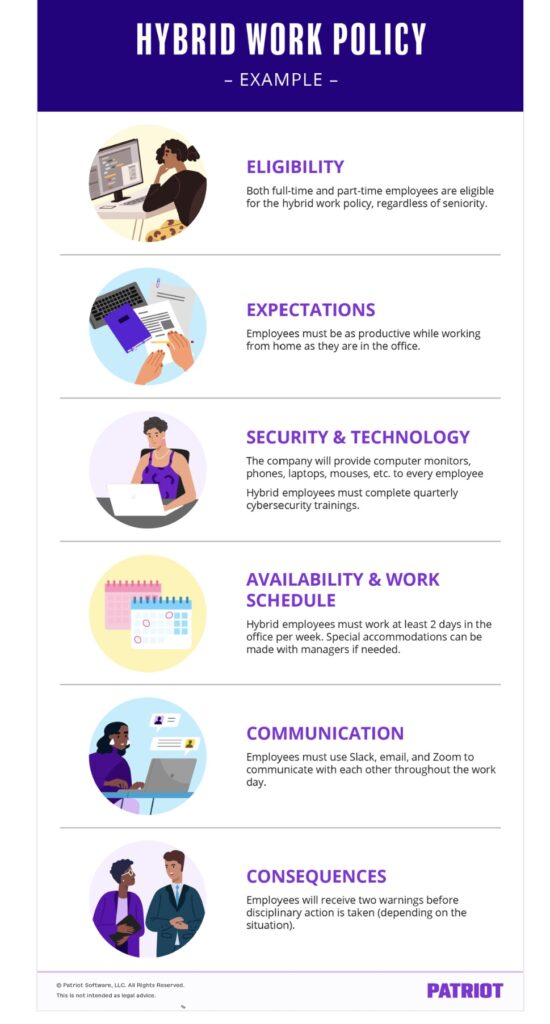- Why DEI in Canada Relies on Inclusion, Not Quotas - May 16, 2025
- Recruiting Videos: Why They Matter & Best Examples - April 10, 2025
- DEI Rollbacks: What Companies Are Doing in 2025 - April 1, 2025
Hybrid work policies are a key consideration for almost all companies operating in the post-COVID world.
In 2023, a study discovered that 74% of companies in the United States either use or want to start using a permanent hybrid work model. Also, 44% of employees in the US like the idea of a hybrid work model, while 51% of employers do. So, this is the hybrid model — team members work between 1 and 4 days from a remote location and attend the corporation’s office space on the remaining days.
Although a hybrid work model is not a new idea, the volume of positions offering it is. So, with this comes a need for many corporations and HR professionals to formalize their hybrid work policies.
In this article, you’ll find:
- 4 examples of hybrid work policies
- the difference between hybrid and flexible work arrangements
- statistics on hybrid working, 100% remote employees, and in-person work
- a free copy/paste hybrid work policy template
But first, let’s clarify the difference between a hybrid workplace and flexible working.
Flexible vs Hybrid Work Policies
Hybrid workers split their time between a remote office location – usually their home office – and the company office. A hybrid work schedule usually takes the form of 1-4 days working from the remote office location. So, for the remaining work hours, the staff members work from the physical office. However, in some cases, a hybrid workspace may allow for other hybrid arrangements. For example, team members may only come in for team meetings but otherwise work remotely. Thus, the hybrid work model is always about the location of work.
In contrast, flexible work policies pertain to location and hours of work, including part-time hours. So, a flexible work policy example could be a team member with young children finishing work at a time that allows them to collect their children from school.
In addition, flexible work arrangements are often considered on a case-by-case basis. But they are also common to many industries or to a particular position. For example, in real estate, it is common for agents to have an office, be out of the office doing viewings, and work varying hours. So, these positions and industries appeal to workers who like the freedom of setting their own hours. Also, it appeals to those who prefer not to be tied down to one location on a regular basis.
Important stats to note about Hybrid Work Policies:
Fun fact: In the UK, companies must consider an employee’s request for flexible working arrangements and can only deny it based on specific guidelines.
In the US, 80 million workers are engaged in flexible work (the workforce totals approximately 166.95 million). But, a hybrid work environment may represent the future of work:
The hybrid model is expected to grow from 42% (2021) to 81% (2024).
Is corporate America ready for The Future of Work? by Kennedy Pereira
Remote working – where employees are never expected to attend in person – has declined in the years following COVID. So, 16% of the workforce works entirely in a remote environment. Perhaps unsurprisingly, the Computer and IT sector leads the industries in this arena.
Hybrid Work Policies: Examples
Now we have an understanding of the differences between hybrid work policies, flexible work policies, and remote work arrangements, let’s take a look at 4 examples of hybrid work policies.
Fordham University – Hybrid Work Policy
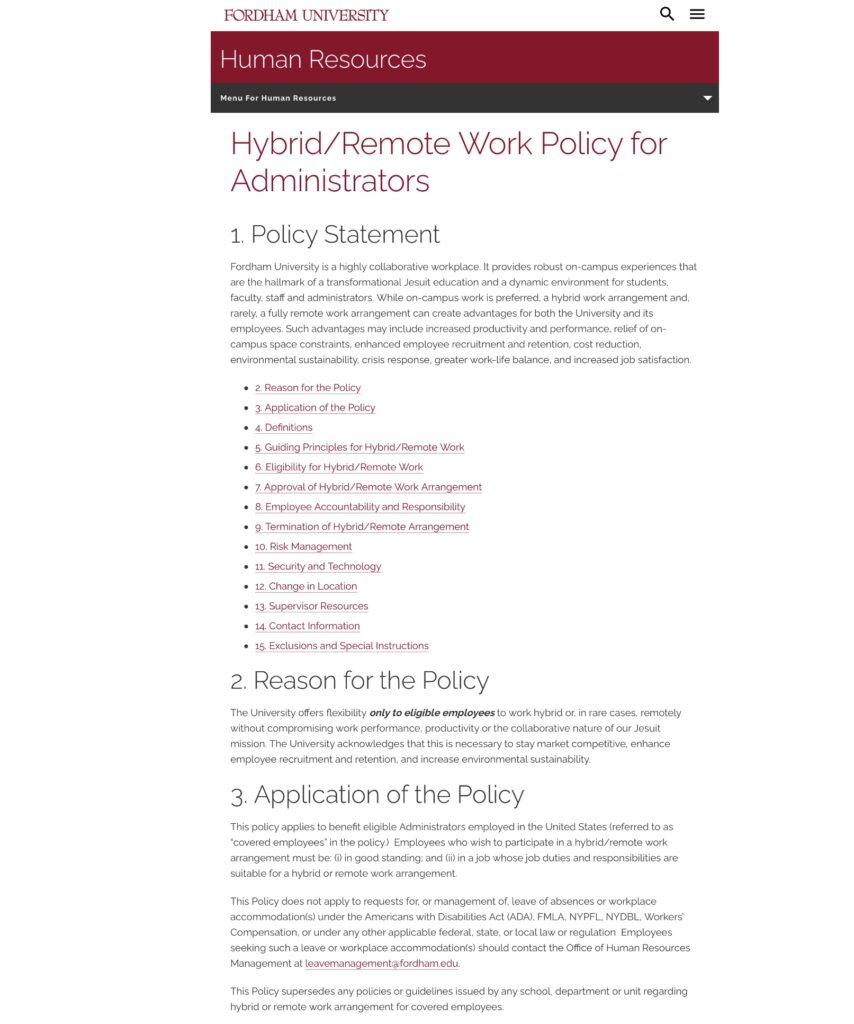
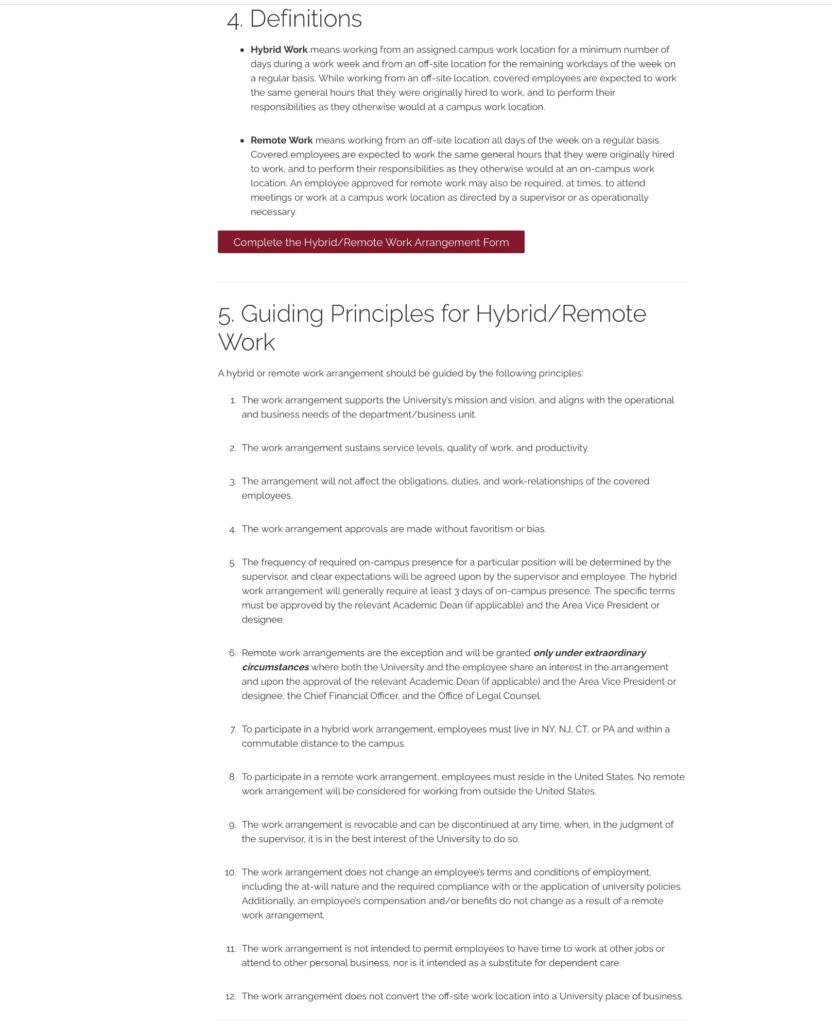
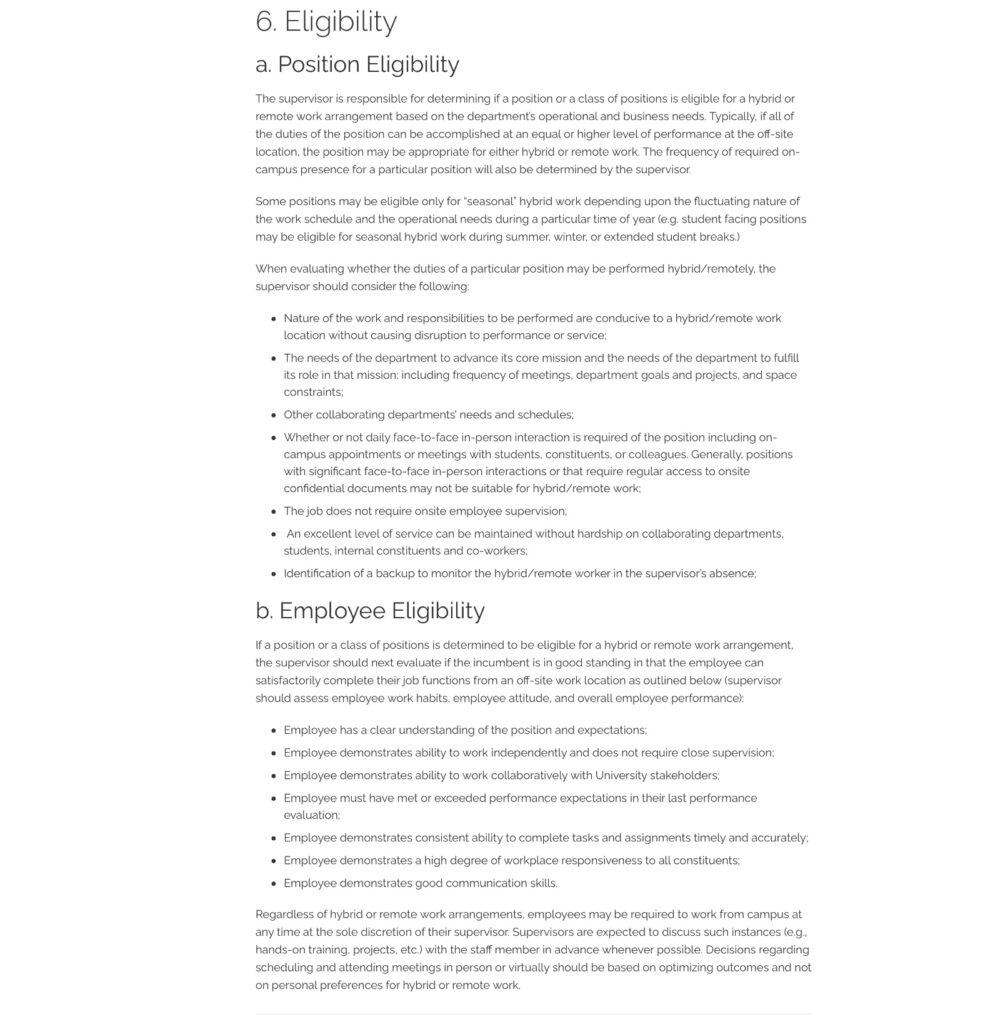
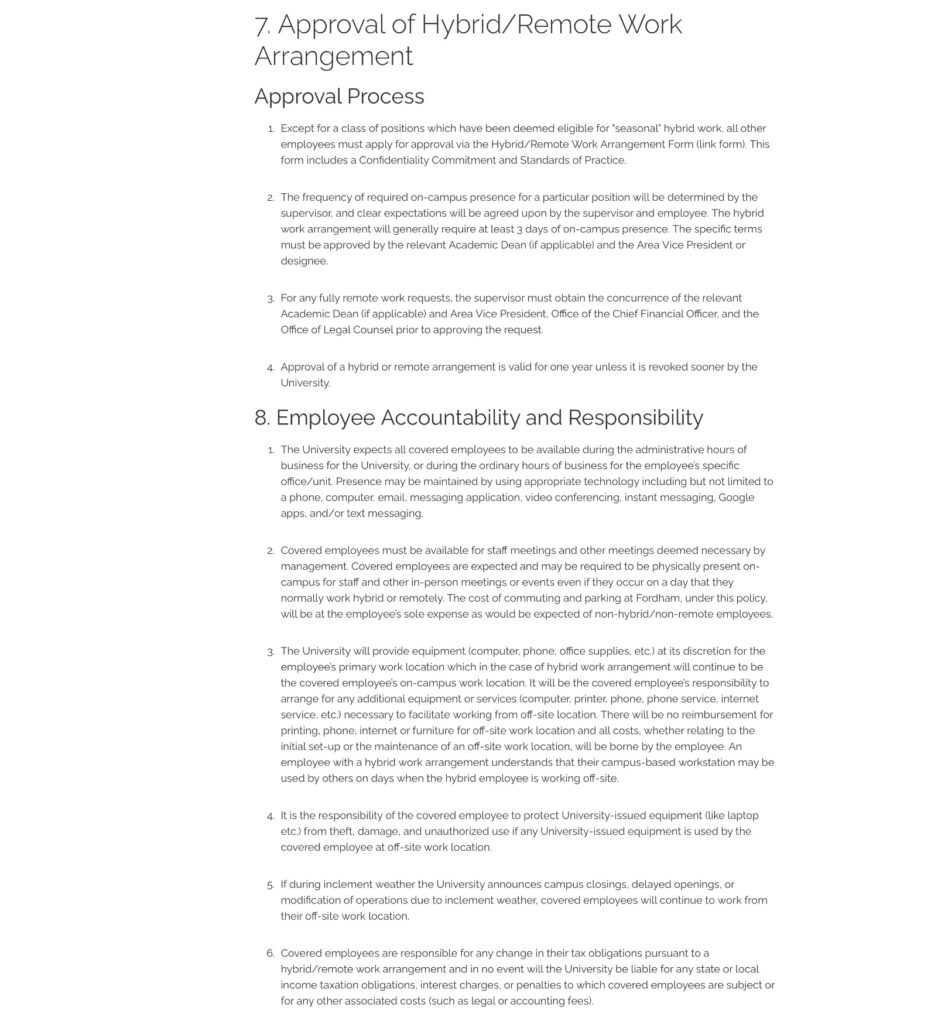
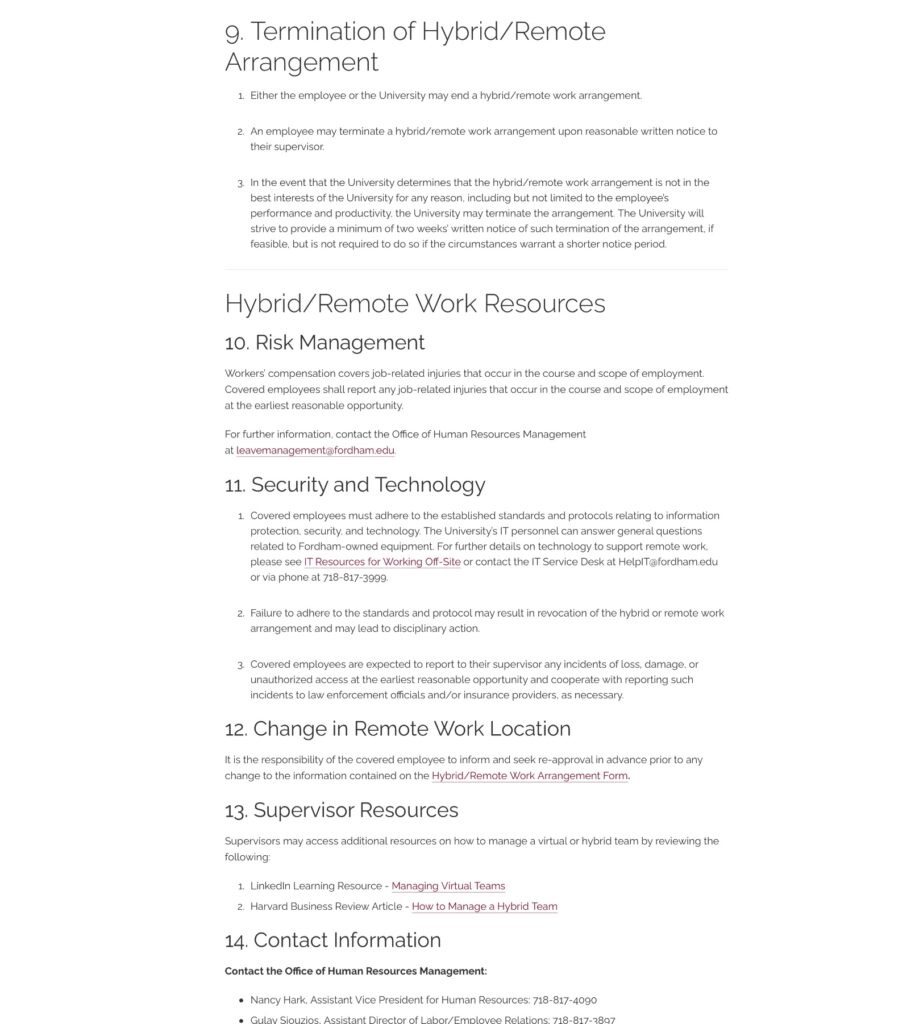
Wagner University – Hybrid Work Policy
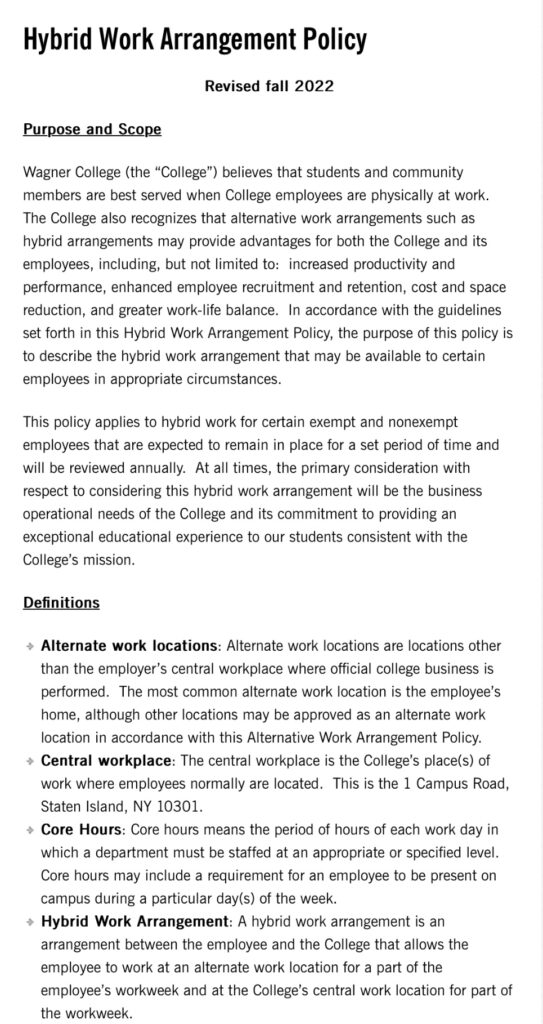

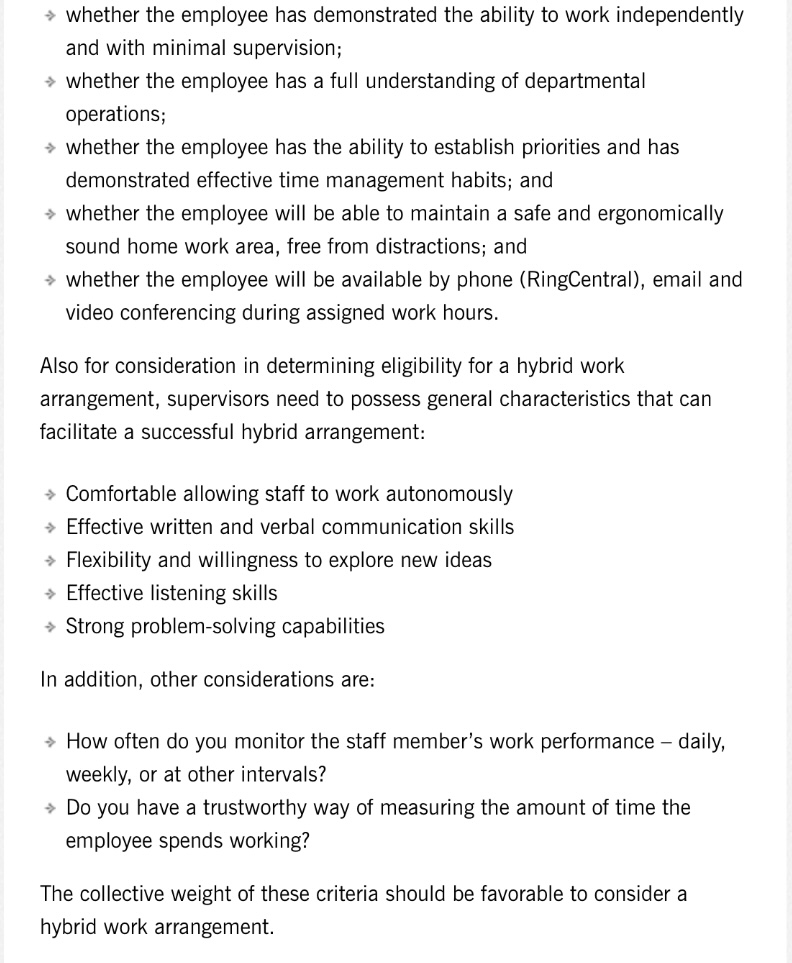
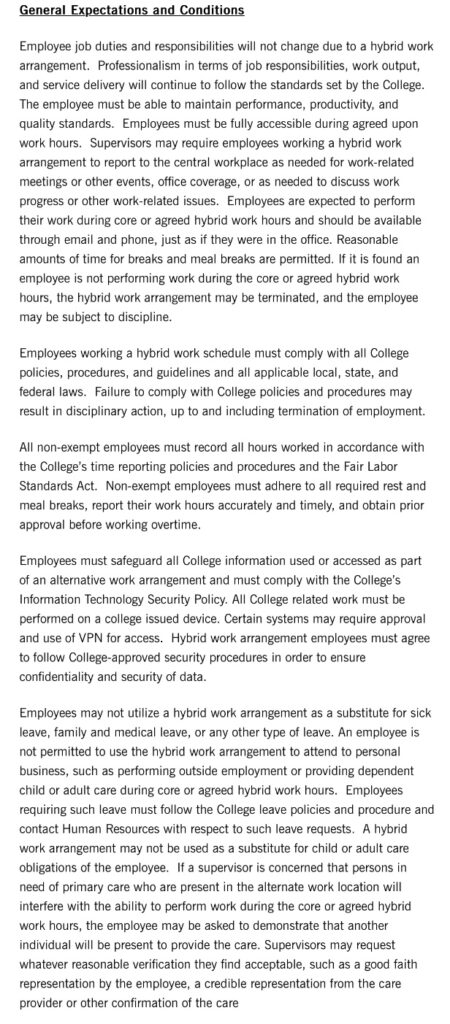
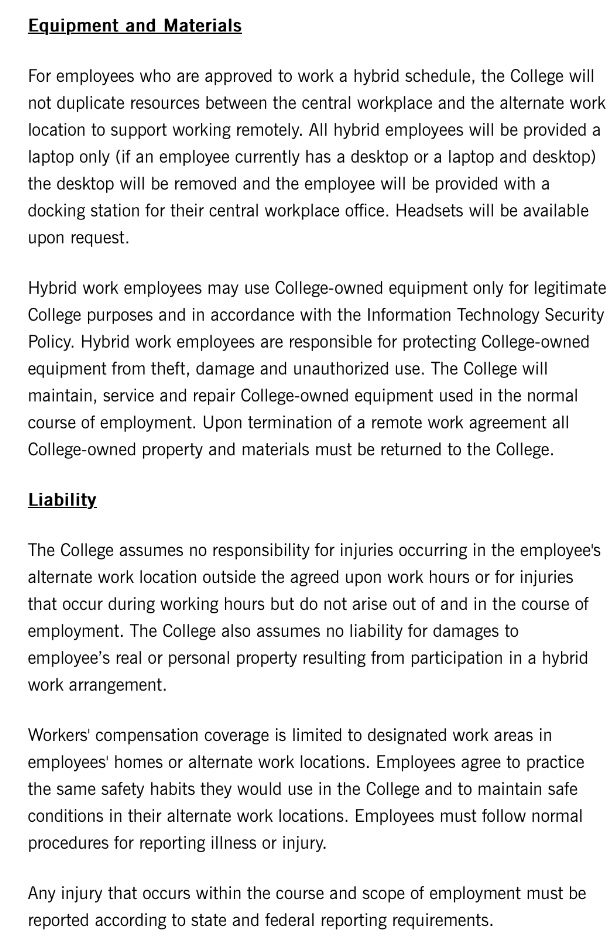
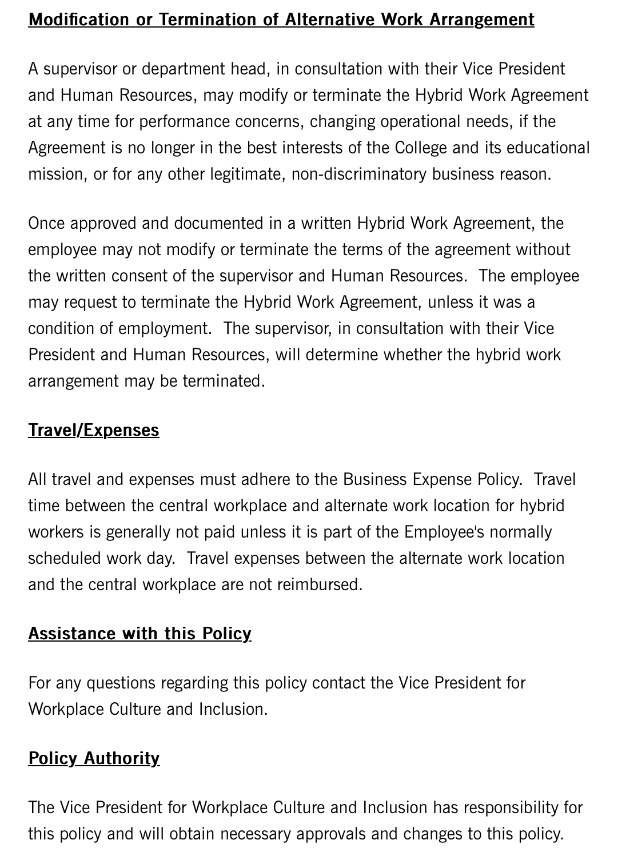
Patriot Software – Hybrid Work Policy Template
Trucking HR Canada – Hybrid Arrangements excerpt
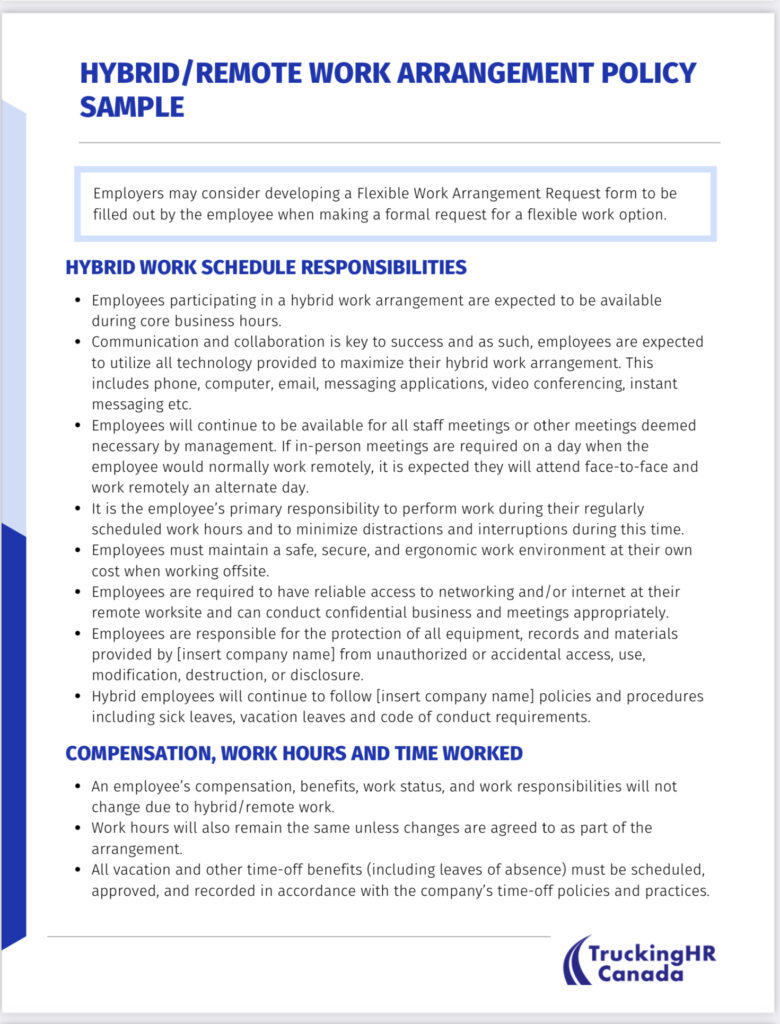
Hybrid Work Policies: Template [copy & paste]
You can use this hybrid policy template to create your own hybrid policy. But remember that writing a hybrid work policy is only the first step. So, the hybrid arrangements policy must be distributed and communicated effectively to your team members.
Company Statement
Write about your company’s position on in-person, hybrid, and remote work. For example:
- in-person preferable
- hybrid is encouraged
- 100% remote opportunities for some positions
Eligibility
If employees need to meet certain criteria to be eligible to work remotely, list those requirements here. For example:
- seniority
- location
- role type
- past performance
Expectations
- state when the employees are expected to be in the physical office
- explain productivity expectations
- be specific about special events that will require in-person attendance
The more detail in this section, the better.
Security
In this section, include information on technology and access to the physical office. For example:
- corporate laptops
- ID badges
Communication and Accessibility
Let your employees know how they will be contacted and how accessible they must be. For example:
- contactable by company cell phone and Zoom during office hours
- must have the ability to join an unscheduled video meeting without notice
- must adhere to a strict one on one meeting schedule once per week
How to Apply/Learn More
Let your team members know who to contact to apply or to obtain more information on the policy.
Why Hybrid Work Policies Benefit Business
Still unsure? Consider these points in favor of hybrid work schedules:
- An increase in work-life balance leads to more satisfied employees
- People working in more comfortable and personalized settings leads to higher productivity and also efficiency
- Less in-person employees reduces overhead costs for the business
- More options for employee schedules and locations creates access to a wider talent pool
- Satisfied, productive people engage more and retention is improved (another cost-saver)
Embracing the Best of Both: Hybrid Work Policies
In today’s fast-paced work world, more and more professionals are choosing hybrid work setups. Thus, combining the flexibility of remote work with the familiarity of the office. So, here are some examples of hybrid work policies that strike the right balance.
1. Flexible Schedules for Everyone
One popular hybrid work policy lets employees choose when and where they work. In effect, a whopping 98% of professionals prefer having the option to include remote work in their long-term careers. So, this means you can tackle your tasks from the comfort of your home. Or you can also collaborate with colleagues in the office. It’s up to you!
2. Positive Vibes with Remote Work
Imagine having a work setup that makes you happy. Well, 91% of professionals say they’ve had a positive experience with remote work. So, some hybrid policies allow employees to spend a few days each week working from home, fostering a positive work-life balance. Therefore, it’s a win-win situation!
3. Balancing Act: The Hybrid Model
Nearly half of employees, around 46%, are following the hybrid model. So, this means they split their time between the office and remote locations. Thus, it’s like having the best of both worlds. So, you get the team spirit of the office. And you also get the freedom of working from wherever suits you best.
4. Tradition Meets Modernity: On-Site Work
While the hybrid approach is gaining popularity, about 34.3% of people still stick to the traditional entirely work model. Some jobs require a hands-on presence and for these professionals, being in the office every day is the norm.
5. Embracing the WFH Lifestyle
For a smaller but notable group, a 19.7% slice of the workforce, full work-from-home (WFH) arrangements are the way to go. So, these employees have fully embraced the idea of conducting business from the comfort of their own homes.
Why are hybrid work policies important?
In today’s evolving work landscape, having a strong hybrid work policy is crucial for businesses. It adapts to the rise of remote work, attracting and retaining top talent. So, best practices involve considering employees’ personal preferences and maintaining effective communication between in-office and remote workers.
Recent surveys show remote work is a lasting trend, making a hybrid work policy essential. So, it clarifies eligibility criteria, ensuring fairness. This policy promotes collaboration in hybrid teams, addressing challenges and fostering a greater work-life balance for employees.
In essence, a comprehensive hybrid work policy is a forward step for any business. It acknowledges diverse workforce needs while ensuring optimal productivity and employee satisfaction. So, embrace a holistic approach for a resilient and adaptive workplace.
Key Considerations for Implementing Hybrid Work Policies
It’s essential to carefully navigate the implementation of a Hybrid Work Policy. Consider these key aspects to ensure a smooth transition that aligns with both business needs and employee satisfaction.
1. Define Eligibility Criteria:
Start by clearly outlining who among your employees is eligible for a hybrid work arrangement. This not only sets expectations but also ensures fairness across the board. So, consider factors like job duties, performance, and the nature of work.
2. Foster Effective Communication:
Effective communication is the glue that holds hybrid teams together. Therefore, you must clearly show how communication will flow between office and remote workers. So, leverage tools like video calls and Microsoft Teams to bridge the gap and maintain a cohesive company culture.
3. Address Challenges Proactively:
Anticipate and address potential challenges. From video conferencing hurdles to the need for face-to-face interaction, tackle these issues head-on.
4. Flexibility for Personal Preferences:
Know that each employee is unique. So, allow room for personal preferences within the hybrid work policy. This could mean choosing the best place to work, whether it’s at home, a coffee shop, or in the office.
5. Time Management and Work Week Structure:
Create a hybrid schedule that balances the needs of the business and employees. So, consider setting a specific period of time for remote work while making sure that teamwork continues in the office. This helps in optimizing the work week for everyone.
6. Employee Feedback Loop:
Set up a way for employees to share their thoughts on the hybrid work rules. So, this will make them happier at work. Also, it will allow you to improve the rules based on what really happens.
7. Navigate Weather and Remote Environments:
Recognize issues like bad weather that could make commuting difficult. Also, make sure that people working from home have a good setup there. So, this not only helps them work better but also supports the balance between work and personal life that hybrid work offers.
8. Consider Family Dynamics:
When people work in a hybrid way, family life is also involved. Pay attention to how family members might affect someone’s work at home. This kind of inclusiveness makes a workplace culture that supports everyone.
Future of Hybrid Work
As we go into the future of work, there are many exciting possibilities and new ways of balancing our work and personal lives. So, moving towards hybrid work imore than just a trend. It’s also a big change that fits the changing needs of both companies and employees.
1. New Ways of Working:
The future of hybrid work means we’re changing how we work. It’s about figuring out the best way to work that fits the different needs of today’s workers. This might include a schedule that mixes working in the office with the freedom to work from home.
2. Evolution of Company Culture:
Companies are seeing a shift in their cultures. So, the hybrid work policy is crucial for creating a culture that values flexibility, good communication, and what employees prefer. Thus, it’s not just about the physical office but also about making people feel they belong whether or not they choose to work at the office or remotely.
3. Overcoming Challenges with Collective Solutions:
Understanding the main problems is important for overcoming obstacles. Therefore, working together on solutions, using good communication, and feedback, will be necessary to improve the hybrid work model.
4. Impact on Employee Satisfaction:
Hybrid work really affects how happy employees are. When companies let workers choose where they work, it helps employees feel valued and supported in their jobs.
5. Embracing Technology for Seamless Collaboration:
The future of hybrid work is connected to technology. So things like video calls and tools like Microsoft Teams are important for keeping good communication between people working from home and those in the office. Therefore, using technology like this helps everyone work together better, no matter where they are.
6. Adapting to Changing Work Environments:
Companies must adjust to different remote work settings, like home offices or coffee shops. So, whether it’s supporting home-based work or considering the preferences of those who like to move around in the office, being flexible matters.
7. Balancing Work-Life Dynamics:
The main idea of hybrid work is to have a better balance between work and personal life. So, this means dealing with things like sick leave, travel time, and bad weather issues. It’s about making a work environment that cares for the overall happiness of employees.
Who is Responsible for the Hybrid Work Policies?
Making a Hybrid Work Policy is a group effort. Therefore, it includes different people to make sure it fits what the company and its employees need.
1. Human Resources (HR):
HR is crucial in making the hybrid work policy. So, they need to know what the company needs, look at good ways other companies do things, and turn that into a policy that shows what the organization values and wants to achieve..
2. Collaboration with Department Heads:
To make the policy fit the specific tasks and issues of each department, You must work together with department heads. So, this makes sure that the hybrid work policy works well and makes sense for different teams.
3. Involvement of Employees:
Ask for employees’ thoughts and include eligible workers in the process when making decisions. As a result, the policy becomes an agreement that considers what people want and how happy they are at work. Thus, getting feedback from employees helps improve the policy to better suit the needs of everyone.
4. Leadership and Company Culture:
Leaders, at any level, are really important in creating the company’s culture. Therefore, they need to make sure communication is good and there’s face-to-face talk, either in person or through video calls. So, the hybrid work policy should show that the company is dedicated to keeping a positive work atmosphere.
5. Adapting to New Ways of Work:
Always be open to welcoming new ways of working. So, leaders and HR need to adjust the policy to keep up with trends, like the growth of hybrid teams and more use of video calls.
6. Legal and Compliance Considerations:
To avoid disciplinary action and ensure compliance, legal experts should check the hybrid work policy. So, this involves looking at things like the agreement everyone made together, who can be part of it, and the work conditions. Thus, having legal experts involved makes sure the policy is solid and can be checked carefully.
7. Employee Recruitment and Onboarding:
The hybrid work policy is important not just for current employees but also for bringing in new ones. Therefore, making the policy clear when hiring and introducing new employees helps them know what to expect and fit in well with the company’s hybrid work style.
8. Ongoing Evaluation and Adaptation:
Making the policy isn’t the end of the job. It’s also important to keep checking how things are going, including looking at how well employees are doing and fixing any issues with their jobs. So, doing this regularly helps make sure the hybrid work policy keeps working well and can change if needed.
The Challenges of a Hybrid Work Model
One of the biggest challenges companies face is setting up a system that caters to the needs of both in-office and remote workers. Balancing the business needs while ensuring that eligible employees can benefit from a flexible work week requires careful consideration. So, HR plays a crucial role in crafting a remote work policy that reflects the company’s culture and values.
Communication is at the heart of a successful hybrid work model. With employees spread across different locations, relying on effective communication tools like video calls and Microsoft Teams becomes essential. So, ensuring everyone is on the same page and fostering a sense of connection, whether through face-to-face interaction or virtual meetings, contributes to maintaining a cohesive company culture.
In addition, eligibility criteria are another aspect that needs attention. Determining who can work remotely and under what conditions is crucial. Therefore, setting up a clear remote work policy that specifies eligibility criteria helps in avoiding confusion. It also ensures fair treatment for all employees.
Addressing the personal preferences of employees is vital for a hybrid work model to thrive. Some may prefer working in a circular setting in the office, while others thrive in a coffee shop environment or at home. Thus, acknowledging these preferences and creating a policy that accommodates different work styles helps with job satisfaction.
Additional consideration
Also, don’t forget to address additional costs that may arise. So, this includes providing resources for remote environments and considering any extra expenses for in-office and remote workers alike. Therefore, balancing these costs while maintaining the purpose of the policy—creating a work environment that supports a greater work-life balance—is essential.
Furthermore, a hybrid work policy must be regularly evaluated to ensure its effectiveness. So, this involves assessing employee performance, addressing job profile flags, and seeking feedback from both in-office and remote workers. Also, this ongoing process helps in adapting the policy to changing circumstances and maintaining a positive company culture.
Why I wrote this
Ongig is on a mission to support HR professionals in creating awesome, diverse workspaces with software like our Text Analyzer. Book a demo here.
Shout-Outs:
- The Difference Between Hybrid and Flexible Work (by Citation)
- 30 Essential Hybrid Work Statistics [2023]:Hybrid Work Model, Data, and Productivity (by Abby McCain)
- 19 IMPORTANT HYBRID WORKING STATISTICS TO KNOW NOW AND FOR THE FUTURE (by Apollo Technical)
- Hybrid Work Policies: The Future of the Modern Workplace (by Dr. Gleb Tsipursky)
- What is a Hybrid Work Policy and Why Does Every Company Need One? (by Steve Todd)
- Hybrid/Remote Work Policy for Administrators (by Fordham University)
- Hybrid Work Arrangement Policy (by Wagner College)
- Hybrid work policy and guidelines: a guide to nailing them (by Tiffany Fowell)
- Create a Hybrid Work Policy to Foster a Culture of Trust & Transparency (by Sarah Altemus)
- Remote and Hybrid Work Policy (by Gettysburg College)
- 6 Things You Absolutely Must Include in Your Hybrid Work Policy (by Maria Tanski-Phillips)
- 2022 State Of Remote Work (by Buffer)
- Americans are embracing flexible work—and they want more of it (by André Dua, Kweilin Ellingrud, Phil Kirschner, Adrian Kwok, Ryan Luby, Rob Palter and Sarah Pemberton)
- Monthly civilian labor force in the United States from June 2021 to June 2023 (by statista)
- Remote Work Statistics And Trends In 2023 (by Kathy Haan)
- Remote Work Statistics & Trends: The Latest in Remote Work (by Jessica Howington)
- Is corporate America ready for The Future of Work? (by Kennedy Pereira)
- HYBRID/REMOTE WORK ARRANGEMENT POLICY SAMPLE (by Trucking HR Canada)
